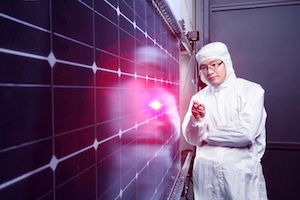
by Yariv Cohen, Ignite Power
Leshan city, in the Sichuan province of southeast China, is an industrial zone, 120 kilometers (75 miles) away from Chengdu. The city boasts a 71-meter (233-feet) high ancient Buddha that was built in the 7th century, and is the largest carved stone sculpture in the country. It is also the planned location for the construction of a 10-GW solar-cell factory, expected to be built with a total investment of RMB4.3 billion [US $652 million]. The factory is only one of many others expected to be constructed in the coming year, as part of China’s globally-leading PV manufacturing scheme.
For the past decade and a half, China became the dominant player in the PV manufacturing field, after the sector received critical help from government subsidies back in 2004. Between 2006 and 2013, China’s global share of production of PV cells, the solar industry’s core technology, surged from 14 percent to 66 percent. During this time prices of solar panels including installation, shipment, and average price per watt of PV capacity sharply dropped, some by over 80 percent, while the global market grew eighteen-fold.
Manufacturing at an unprecedented pace
In the early 2000’s, China set its sight on the solar industry, and began hiring international solar experts and shopping for the necessary manufacturing machinery, while inviting global market leaders to move their manufacturing to the country, where they could find cheap, skilled labor, and tax credits. The federal government released vast subsidies and invested as much as $47 billion to help build its solar manufacturing into what it calls a “strategic industry.” Expanding renewable energy became one of seven categories of business that receive special attention including loans and tax incentives under China’s five-year plans.
The investment was undoubtedly enormous, but this time around, production capacity expansion is at a much larger scale than ever before. According to official announcements by Chinese PV companies, the total invested capital in PV manufacturing in 2020 exceeded CNY 300 billion ($47 billion), and 2021 will see even bigger numbers, with production capacities for PV module components and accessories – including racking and trackers, inverters, EVA/POE film, PV glass, backsheets, and even aluminum frames are expected to witness significant expansion.
As China’s global dominance settled, the entire market was forever changed. Extreme price decreases made solar PV an accessible product, and solar electricity began spreading across developing countries, allowing the most impoverished communities to gain access for the first time. But alongside vast development, China’s dominance has some darker sidesת שs competitive prices drove many global players out of business. With the majority of the industry focused in one country, and without any real incentives for entrepreneurs to enter the market and pursue new ideas and inventions, the industry’s course of innovation shifted, and further advancements were hampered.
An innovative industry, minus the innovation
While PV prices dropped, efficiency of the panels rose, and process innovation thrived all thanks to ongoing development of the market and various inventions, conventional indicators of product innovation, such as patenting and the ratio of research and development (R&D) to sales dropped. As new technological developments fall relatively flat, the sector risks a “technological lock in” and new technologies might have to struggle to achieve commercial deployment.
And these new technologies are key, as solar energy plays a major role in the fight against climate change. The International Energy Agency’s (IEA) latest and most comprehensive assessment of clean energy progress assesses a full range of energy technologies and sectors. Only 6 out of 46 technologies and sectors were “on track” with the agency’s Sustainable Development Scenario, which maps out a pathway to reach the Paris Agreement goals, and solar was one of those 6.
As prices declined, solar power became competitive with fossil fuels, even reaching grid parity in some places including China, Italy and California. In developing countries, where grid connectivity is often not an option for many living in rural areas, solar power is helping millions gain access to electricity for the first time, and entire villages are solar-relient, leaving polluting fossil fuels behind.
Without the proper volume of innovation that is needed to take the sector forward, global efforts to reduce greenhouse gas emissions might fall short of those needed to avoid the worst consequences of climate change. When striving to reach zero net emissions by 2050, governments around the world might consider allocating resources to R&D of the sector, to kick start innovation and continue pushing the sector forward.
About the Author
Yariv Cohen is one of the founders and Chief Executive Officer of Ignite Power Ltd. Prior to founding and leading Ignite, Yariv was President of Camco Clean Energy , a global renewable energy developer with a focus on Africa. He is also a founding partner of Ignite Investments, an investment firm, scaling innovation globally to help build Africa and the Middle East’s sustainable future. He is a member of Young Presidents’ Organization (YPO) and currently serves as its Chair of Global Diplomacy and Public Policy Network.





